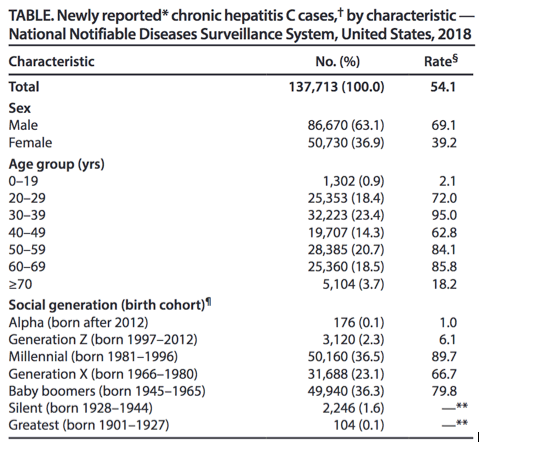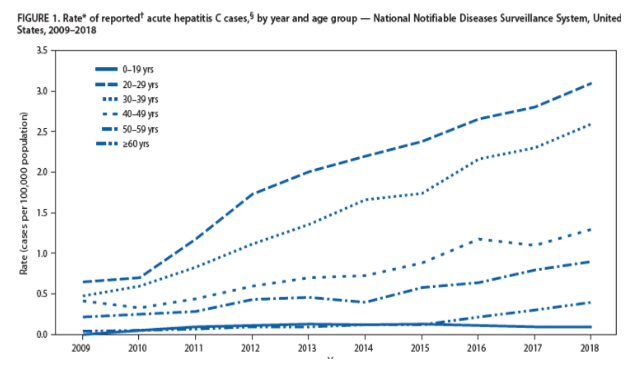| |
|
CDC: During 2009-2018 the number of reported acute hepatitis C cases per 100,000 population increased threefold.
|
| |
| |
Download the PDF here
Still there is no federal funded national screening program. US last in the world in HCV elimination
....Among both males and females, a bimodal age distribution was observed, with the largest proportion of all newly reported chronic cases among persons aged 20-39 and 50-69 years (Figure 2). .....These findings support the CDC's new recommendation that all adults age 18 and older-not just baby boomers-should be screened for HCV at least once unless the local prevalence of the virus is very low.....Rising hep C rates among people of childbearing age has led to a growing risk of mother-to-child transmission of HCV, and the CDC now advises women to get tested during each pregnancy. People of any age should be tested if they are at higher risk for hep C, and those who currently share needles or other drug injection equipment should receive regular HCV testing as long as they remain at risk.
The rate of acute, or newly acquired, hepatitis C tripled between 2009 and 2018, according to a recent report from the Centers for Disease Control and Prevention (CDC). What's more, the liver disease now affects every generation, with new cases of chronic hep C among millennials-largely associated with the opioid crisis-equaling those among baby boomers.
An estimated 2.4 million people are living with chronic hepatitis C virus (HCV) infection, and around 40% of them do not know they carry the virus. Although some people with newly acquired HCV will clear the virus spontaneously without treatment, more than half develop chronic infection lasting more than six months.
As described in the April 10 Morbidity and Mortality Weekly Report, 3,621 cases of acute HCV were reported to the CDC in 2018, representing an estimated 50,300 total new cases after underreporting is taken into account. The rate of new infections increased by about 300% among people ages 20 to 29 and by about 400% among those ages 30 to 39. see Figure 1 just below.
In addition, the CDC received reports of 137,713 new cases of chronic hepatitis C during the same year. Nearly two thirds (63.1%) were in men. Millennials (people born between 1981 and 1996) accounted for 36.5% of these cases, compared with 36.3% among baby boomers (those born between 1945 and 1965) and 23.1% among generation X (those born between 1966 and 1980).
These findings support the CDC's new recommendation that all adults age 18 and older-not just baby boomers-should be screened for HCV at least once unless the local prevalence of the virus is very low.
Along with more hep C testing and treatment, the CDC recommends expanded prevention services, including syringe access programs and medication-assisted treatment (for example, using methadone or buprenorphine) for people with substance use disorder. These services can be provided in a range of settings, such as primary care clinics and emergency departments.
There remains NO nationally funded HCV screening, linkage to care program in the USA. The US ranks among the very last globally on the road to HCV Elimination as laid out by WHO. Jules


During 2018, a total of 3,621 cases of acute hepatitis C were reported, representing an estimated 50,300 cases (95% CI = 39,800-171,600), after adjusting for underascertainment and underreporting. During 2009-2018, the number of reported acute hepatitis C cases per 100,000 population increased threefold, from 0.3 in 2009 to 1.2 in 2018
The annual rate of reported acute hepatitis C cases per 100,000 population increased threefold, from 0.3 in 2009 to 1.2 in 2018, and was highest among persons aged 20-29 (3.1) and 30-39 years (2.6) in 2018. A bimodal distribution of newly reported chronic hepatitis C cases in 2018 was observed, with the highest proportions among persons aged 20-39 years and 50-69 years. Only 60.6% (95% CI = 46.1%-73.9%) of adults with hepatitis C reported having been told that they were infected.
A total of 137,713 new chronic hepatitis C cases were reported during 2018. A larger percentage of these cases were among males (63.1%) than among females (36.9%) (Table). Among both males and females, a bimodal age distribution was observed, with the largest proportion of all newly reported chronic cases among persons aged 20-39 and 50-69 years (Figure 2). Baby boomers accounted for 36.3% of newly reported chronic hepatitis C cases in 2018, persons born during 1966-1980 (Generation X) accounted for 23.1%, and those born during 1981-1996 (millennials) accounted for 36.5%. (Table). Among 2015-2018 NHANES participants aged ≥20 years who were HCV RNA-positive, 60.6% (95% CI = 46.1%-73.9%) reported having been told that they had hepatitis C.
These findings highlight the need for immediate implementation of the new CDC universal hepatitis C screening recommendations for all adults and pregnant women (11). Following a decade of sharp increases in acute hepatitis C infections, particularly among young adults, the rates of newly reported chronic infections among baby boomers and millennials are now equal, demonstrating that even younger generations are at risk. Diagnosing HCV infection is a necessary first step to linking persons to cure to prevent life-threatening consequences of long-term chronic infections and transmission to others.
CDC - Vital Signs: Newly Reported Acute and Chronic Hepatitis C Cases - United States, 2009-2018
Weekly / April 10, 2020 / 69(14);399-404
https://www.cdc.gov/mmwr/volumes/69/wr/mm6914a2.htm
A. Blythe Ryerson, PhD1; Sarah Schillie, MD1; Laurie K. Barker, MSPH1; Benjamin A. Kupronis, MPH1; Carolyn Wester, MD1
Summary
What is already known about this topic?
Acute hepatitis C infection is often asymptomatic, but >50% of cases will progress to chronic infection, which can be life-threatening. Hepatitis C can be diagnosed with a blood test and is curable.
What is added by this report?
The annual rate of reported acute hepatitis C tripled from 2009 to 2018 and was highest among persons aged 20-39 years. In 2018, the largest proportion of chronic hepatitis C cases
occurred among persons aged 20-39 years and 50-69 years. Only 61% of adults with hepatitis C knew that they were infected.
What are the implications for public health practice?
All adults and pregnant women should be screened for hepatitis C according to CDC's new screening recommendations.
Abstract
Introduction: Hepatitis C is a leading cause of death from liver disease in the United States. Acute hepatitis C infection is often asymptomatic, and >50% of cases will progress to chronic infection, which can be life-threatening. Hepatitis C can be diagnosed with a blood test and is curable, yet new cases of this preventable disease are increasing.
Methods: National Notifiable Diseases Surveillance System data were analyzed to determine the rate of acute hepatitis C cases reported to CDC by age group and year during 2009-2018 and the number and rate of newly reported chronic cases in 2018 by sex and age. The proportion of adults aged ≥20 years with hepatitis C who reported having ever been told that they had hepatitis C was estimated with 2015-2018 National Health and Nutrition Examination Survey data.
Results: During 2018, a total of 3,621 cases of acute hepatitis C were reported, representing an estimated 50,300 cases (95% confidence interval [CI] = 39,800-171,600). The annual rate of reported acute hepatitis C cases per 100,000 population increased threefold, from 0.3 in 2009 to 1.2 in 2018, and was highest among persons aged 20-29 (3.1) and 30-39 years (2.6) in 2018. A bimodal distribution of newly reported chronic hepatitis C cases in 2018 was observed, with the highest proportions among persons aged 20-39 years and 50-69 years. Only 60.6% (95% CI = 46.1%-73.9%) of adults with hepatitis C reported having been told that they were infected.
Conclusions and Implications for Public Health Practice: Increasing rates of acute hepatitis C among young adults, including reproductive-aged persons, have put multiple generations at risk for chronic hepatitis C. The number of newly reported chronic infections was approximately equal among younger and older adults in 2018. The new CDC hepatitis C testing recommendations advise screening all adults and pregnant women, not just persons born during 1945-1965, and those with risk factors.
Results
During 2018, a total of 3,621 cases of acute hepatitis C were reported, representing an estimated 50,300 cases (95% CI = 39,800-171,600), after adjusting for underascertainment and underreporting. During 2009-2018, the number of reported acute hepatitis C cases per 100,000 population increased threefold, from 0.3 in 2009 to 1.2 in 2018. During 2018, the highest rate of reported acute hepatitis C cases was in persons aged 20-29 years (3.1 per 100,000), followed by persons aged 30-39 years (2.6), 40-49 years (1.3), 50-59 years (0.9) and ≥60 years (0.4); the lowest rate (0.1) was in persons aged <20 years (Figure 1). This age pattern was consistent throughout 2009-2018, but the absolute increase in the annual case counts per 100,000 was highest for persons aged 20-39 years; among those aged 20-29 years, rates increased approximately 300%, from 0.7 in 2009 to 3.1 in 2018, and among those aged 30-39 years, rates increased approximately 400%, from 0.5 in 2009 to 2.6 in 2018.
A total of 137,713 new chronic hepatitis C cases were reported during 2018. A larger percentage of these cases were among males (63.1%) than among females (36.9%) (Table). Among both males and females, a bimodal age distribution was observed, with the largest proportion of all newly reported chronic cases among persons aged 20-39 and 50-69 years (Figure 2). Baby boomers accounted for 36.3% of newly reported chronic hepatitis C cases in 2018, persons born during 1966-1980 (Generation X) accounted for 23.1%, and those born during 1981-1996 (millennials) accounted for 36.5%. (Table). Among 2015-2018 NHANES participants aged ≥20 years who were HCV RNA-positive, 60.6% (95% CI = 46.1%-73.9%) reported having been told that they had hepatitis C.
| |
| |
| |
|
|
|